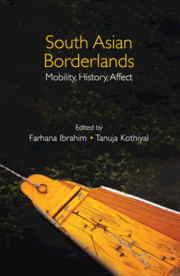Book contents
- Frontmatter
- Contents
- List of Figures and Tables
- Acknowledgements
- Introduction
- 1 Paradise at the Frontier: Kashmir as a Political Terrain and Literary Landscape in the Mughal Empire
- 2 Borders in the Age of Empire and Nation-States: The Honeycomb of Borderlands: Kumaun, Western Tibet and Far Western Nepal
- 3 Borders, Difference, Recognition: On the Cause(s) of Gorkhaland
- 4 Embattled Frontiers and Emerging Spaces: Transformation of the Tawang Border
- 5 Relative Intimacies: Belonging and Difference in Transnational Families across the Bengal Borderland
- 6 Reading Parijat in Nepal: The Poetics of Radical Feminism Negotiating Self and Nation
- 7 Commodity Journeys and Market Circuits: Making Borders ‘Natural’ in Colonial Western Himalayas
- 8 Frontiers, State and Banditry in the Thar Desert in the Nineteenth Century
- 9 Bureaucracy and Border Control: Ethnographic Perspectives on Crime, Police Reform and ‘National Security’ in Kutch, 1948–52
- 10 Frontier as Resource: Law, Crime and Sovereignty on the Margins of Empire
- About the Contributors
- Index
2 - Borders in the Age of Empire and Nation-States: The Honeycomb of Borderlands: Kumaun, Western Tibet and Far Western Nepal
Published online by Cambridge University Press: 17 September 2021
- Frontmatter
- Contents
- List of Figures and Tables
- Acknowledgements
- Introduction
- 1 Paradise at the Frontier: Kashmir as a Political Terrain and Literary Landscape in the Mughal Empire
- 2 Borders in the Age of Empire and Nation-States: The Honeycomb of Borderlands: Kumaun, Western Tibet and Far Western Nepal
- 3 Borders, Difference, Recognition: On the Cause(s) of Gorkhaland
- 4 Embattled Frontiers and Emerging Spaces: Transformation of the Tawang Border
- 5 Relative Intimacies: Belonging and Difference in Transnational Families across the Bengal Borderland
- 6 Reading Parijat in Nepal: The Poetics of Radical Feminism Negotiating Self and Nation
- 7 Commodity Journeys and Market Circuits: Making Borders ‘Natural’ in Colonial Western Himalayas
- 8 Frontiers, State and Banditry in the Thar Desert in the Nineteenth Century
- 9 Bureaucracy and Border Control: Ethnographic Perspectives on Crime, Police Reform and ‘National Security’ in Kutch, 1948–52
- 10 Frontier as Resource: Law, Crime and Sovereignty on the Margins of Empire
- About the Contributors
- Index
Summary
The map, a totalizing stage on which elements of diverse origin are brought together to form the tableau of a ‘state’ of geographical knowledge, pushes away into its prehistory or into its posterity, as if into the wings, the operations of which it is the result or the necessary condition. It remains alone on the stage. The tour describers have disappeared.
—Michele de Certeau, The Practice of Everyday Life (1984), 122Borderlands are not fixed, but contingent, the product of historical circumstances. Modern cartography and state systems constructed ‘frontiers’ and modified exchange and interaction through new governmentalities. Imperial polities and nation-states that replaced them continued to function through such borders, affecting deeply the lives of those at these outposts. I propose to study the impact of such boundaries on communities inhabiting the highlands of South Asia.
This chapter argues that the intrusions of the British imperium into the central Himalayas (Uttarakhand and Far Western Nepal) and the trans- Himalayas (western Tibet) eroded the practice of altitudinal zonation or ‘verticality’ (Rhoades and Thompson 1975: 535–51), which linked variegated bio-geographies of the trans-Himalayas, upper Himalayas, middle Himalayas and the Bhabhar-Tarai in seasonal rhythms for optimal use of natural resources. The dreaded Tarai, in the south, functioned as the natural boundary (with awl fevers and foul vapours). The British transformed the Tarai landscape through rail and road networks which also helped them acquire formal control over the Kumaun Division and informal control over Nepal and Tibet. This reconfiguration modified the northward orientation of the central Himalayas, altered trade flows and affected agro-pastoral regimes, eventually leading to extensive out-migration (towards the south).
An interesting aspect of the mapping of this mountainous terrain was the recognition of the sacred geographies. The connection of the trans-Himalayas, western Nepal and Kumaun through the Kailash Manasarovar circuit, though well known, was now reworked through rail, road, bridle path and other networks. The Gosains of the earlier circuit were replaced by new ascetic groups from the plains. Sacred geographies obscured earlier interconnections and pilgrimage networks overwhelmed and rendered redundant earlier memories and linkages. As the terrain was mapped, this interconnected system became a honeycomb of the borderlands of British India, Tibet and Nepal.
- Type
- Chapter
- Information
- South Asian BorderlandsMobility, History, Affect, pp. 44 - 79Publisher: Cambridge University PressPrint publication year: 2021



